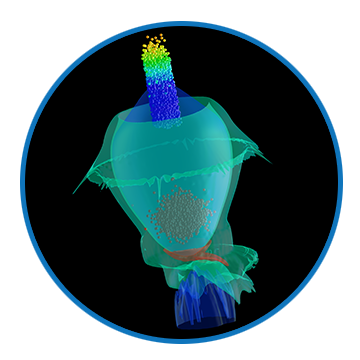Infrastructures
Extreme Plasma Physics Team
The epp team relies on a combination of supercomputers, numerical codes, and visualisation tools to support the research undertaken by our team. Our team members are trained in using these tools to uncover the physics of some of the most extreme scenarios in the laboratory and in the Universe.
Clusters

We have routinely access to the largest supercomputers in the World through competitive calls (e.g. within PRACE) and through our collaborations in the US and in Europe. In 2014, a new 2000 cpu-core cluster will be deployed at IST to support the activity of our team via the ERC Advanced Grant Accelerates. Check the News section for updates on the new cluster and on new supercomputer time allocations for the epp team.
Codes

Our team has access to a suite of massively parallel codes available, covering all plasma scales from the fully relativistic particle-in-cell code OSIRIS 2.0 (kinetic) to the hybrid code dhybrid (hybrid and particle-MHD).
OSIRIS is a state-of-the-art massively parallel particle-in-cell code, with a wide array of features and physics models, jointly developed by the Osiris Consortium, consisting of IST and UCLA. IST manages the links of the Osiris consortium with European institutions. As part of the collaboration strategy of our team, we have signed MoUs with the following institutions: Oslo University (Prof. Erik Adli), University of Strathclyde (Prof. Dino Jarozinzky), DESY (Dr Jens Oshteroff), Max Plank Institute for Physics (Dr Patric Muggli), Max Planck Institute for Quantum Optics (Prof Stefan Karsch), Politecnico di Torino (Prof. Gianni Coppa), and the Rutherford Appleton Laboratory (Prof. Peter Norreys and Dr. Raoul Trines).
Visualization

The visualization infrastructure is based on dedicated servers for visualisation and individual desktops running IDL, also including a suite of visualisation tools over IDL developed internally – VisXD. IST has signed MoUs to distribute VisXD with all the European partners that have signed OSIRIS MoUs and also with Princeton University (Prof. Anatoly Spitkovsky) and the University of Toronto (Prof. B. Mossbarger).
X-GoLP Team
The X-GoLP team investigation is sustained not only by computational simulation and its visualisation, but also by the experimental component, and for such we recur to specific technical tools and facilities. Our team members are trained in using these tools to study experimentally some of the theoretical assumptions made and to test their validity. Below you can find some information regarding the facilities of the Laboratory for Intense Lasers.
The Laboratory for Intense Lasers, located at IST, hosts a 15 TW / 6 J / 400 fs Ti:sapphire/Nd:glass main laser system, and is accessible for European researchers. Further info is provided on the following table:
- – Coherent Mira 900F + Verdi 10
- – 120 fs, 1053 nm
- – Offner type
- – 60 ps/nm, 15 nm full width
- – Ti:sapphire regenerative amplifier
- – Pumped by frequency-doubled Nd:YAG
- – 2 mJ / 10 Hz / contrast 105
- – Grating compressor in air for 2 mJ / 250 fs pulses
- – Nd:glass rod amplifiers (Quantel)
- – Double pass Ø16 mm – 1 J / 3 min
- – Double pass Ø45 mm – 10 J / 20 min
- – Two 140 x 120 mm holographic gratings
- – Vacuum enclosed
- – 2nd and 3rd order autocorrelators
- – Tilted pulse front autocorrelator
- – SPIDER
- – FROG / XFROG
- – Wavefront + beam profile monitor
- – Radial shearing interferometer
- – Near + far field imaging













